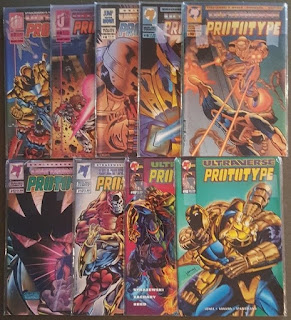Of all the solo Ultraverse heroes, you would think Prototype would be the easiest to figure out. He's a guy in an armored suit who works for a corporation; he's Iron Man. To be more precise, he's what Iron Man was supposed to be back when Tony Stark had a secret identity. It's prolly why I passed over the book back in the 90's when it first came out. It's prolly why I didn't pay much attention to the character in the second volume of Ultraforce, which is where he landed after Black September and his book's cancellation.
So image my surprise to find out that this is something else, with a shifting point of view that comes off at times as a technothriller. In many ways, the titular Prototype isn't the hero, but the catalyst for the action of others.
![]()
UltraTech is proud of its mascot, Prototype...until its operator, Bob Campbell starts believing he's a super-hero for real. So, using the loss of his arm during one combat, Bob is ousted and the armor is upgraded for its next operator, Jimmy Ruiz--literally, as Ruiz is unwittingly a natural ultra whose energy abilities are able to fuel the suit. But both men realize on their own that it's in their own interest to fight back against their employers. Meanwhile, in the background, the 'terrorism corporation' Terrordyne and the Asian Techuza war against each other, involving both our heroes as well as the enigmatic super-scientific samurai Arena.
Visiting these issues for the first time was interesting. I did not expect that it would be focused at times on both Bob and Jimmy, and it was the contrast between the two--and the chemistry between them in later issues--that is the book's biggest appeal. According to Tom Mason, who co-wrote the majority of the book with Len Strazewski (three issues were written by Strazewski solo, with the final issue--easily its worst--a fill-in by R.A. Jones):
"My initial thought was that the book was going to be Bob Campbell's story. After some discussion with Len - all friendly back and forth as we tried to figure things out together - it became clear that Jimmy's story would be the journey to hang everything else on. Jimmy was Len's idea; Iron Man as a teenager learning. Everything else was subplot which would sometime take a larger piece of an issue to move things forward and keep things interesting."
Strazewski added:
"My original intention was explore multigenerational models for heroes and Jimmy led the way with his tattoo tech. The final result was to have two heroes--Prototype and Ranger, sometimes working together with different techniques."
And I think the fact that we had two writers championing two different characters may have made Mason and Strazewski work to make both characters more engaging...and it shows. I never felt that one character's arc was interfering with the other, and it ended up creating a wonderful rapport between Bob, Jimmy and Bob's ex-wife that gave the series heft. What's really remarkable is how seamlessly the series handles weaving itself into the larger crossovers--unlike other titles, there is never a sense that Prototype's main storyline is put on hold so the Break-Thru or Hostile Takeover event happens.
The villains are....iffy with the exception of Arena, who shows up in issue #6 to continue their conflict with Prototype unaware that there's a new operator in the armor. Thankfully, Arena's story arc is resolved in both the Bob Campbell story in Ultraverse Premiere and an issue of Prime V. 2.
I was surprised at how much I took to Prototype. It ended up being a title with one of the most consistent creative teams, and when it hit, it hit hard. My biggest complaint is the fact that it remained unresolved--it ends mid-story with nothing close to a resolution to bring the series to a close. I really recommend it. Hell, if it wasn't for its lack of a satisfying end, it would have been one of my favorite titles in the re-reading.
Until then....why be meta when you can be ultra?















